|
 Hygrophorus gloriae Hygrophorus gloriae
SynonymsGliophorus gloriae
BiostatusPresent in region - Indigenous. Endemic
Images (click to enlarge)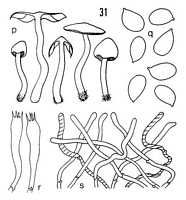
Caption: Hygrophorus gloriae Stev.: p. carpophores. - q. spores. - r. basidia. - s. cuticle (Herb. HK. ZT 68/643) | 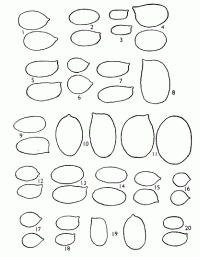
Caption: Spores X 2000 1. Hygrophorus salmonipes 2; H. elsae; 3, H .julietae; 4, H. variabilis; 5, H. lilaceo-lamelllatus; 6, H. muritaiensis; 7, H. keithgeorgei; 8, H. pseudococcineus; 9, H. rubro-carnosus; 10, H. miniceps; 11, H. procerus; 12, H. multic | 
Caption: Fig. 39 Hygrophorus gloriae Stev. (E-G: ZT 1041): E. basidiomes.
F. spores. G. basidia (K 816, type): S. spores. | 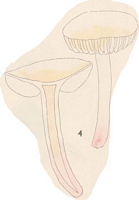 | 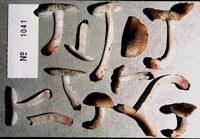
Caption: ZT1041
Owner: E. Horak: © Creative Commons Attribution-Noncommercial 3.0 New Zealand | 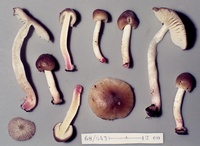
Caption: ZT68-643
Owner: E. Horak: © Creative Commons Attribution-Noncommercial 3.0 New Zealand |
Article: Horak, E. (1971). A contribution towards the revision of the Agaricales (Fungi) from New Zealand. New Zealand Journal of Botany 9(3): 403-462 (http://www.rsnz.org/publish/abstracts.php).
Notes: Hygrophorus gloriae Stevenson (28 D) = Gliophorus gloriae (Stevenson) comb.
nov. (Basionym: H. gloriae Stevenson, Kew Bull. 16: 382, 1962)
Article: Horak, E. (1990). Monograph of the New Zealand Hygrophoraceae (Agaricales). New Zealand Journal of Botany 28(3): 255-306 (http://www.rsnz.org/publish/abstracts.php).
Description: Pileus -45 mm, hemispherical or conical with strongly inrolled margin becoming
umbonate-expanded with plane centre and upturned margin; grey-brown, dark brown
or fuliginous at centre, paler towards margin, fading to whitish in aged basidiomes;
viscid, margin non-striate, glabrous in dry condition. - Lamellae 18-24 (1 -5)
crowded, adnexed to emarginate-subdecurrent; whitish to pale straw yellow, often
with greenish tinge when young, finally becoming whitish, edges concolorous,
entire. - Stipe 25-60 x 4-6 (-10) mm, cylindrical, equal or sub-bulbous at base;
pallid to pale yellow-green at apex, brilliant pink at base; dry, longitudinally
fibrillose, occasionally strigose at base, hollow, fragile, single or caespitose.
- Context brown in pileus, pale yellow-green in upper portion of stipe, pink
in base of stipe. - Odour unpleasant, like Cystoderma carcharias (Fr.).
- Taste mild. - Chemical reactions on pileus: KOH, HCI, and NH3 -
negative.
Spores 6-8 x 4-5.5 um, ovoid to drop-shaped. – Basidia 40-55 x 7-8 um,4-spored.
- Cystidia absent - Pileipellis an ixocutis of cylindrical, densely interwoven
hyphae (4-10 um diam.), membrane strongly gelatinised, with brown plasmatic
pigment clamp connections present (Pl. 1, Fig. 7).
Habitat: ECOLOGY: Scattered; saprobic on soil among litter in broadleaved-conifer forests
dominated by Elaeocarpus, Leptospermum scoparium, Olearia, Podocarpus, Phyllocladus,
Cyathea (C. smithii, C. dealbata). July.
Distribution: distribution: NZ (SA, W).
Notes: In the field H. gloriae is easily recognised and identified by the strong
unpleasant odour and the pink-coloured base of the stipes.
Article: Stevenson, G. (1963) [1962]. The Agaricales of New Zealand: IV. Kew Bulletin 16(3): 373–384.
Description: Pileus 3.5-4 cm, diam., creamy, plane becoming slightly upturned; flesh thin,
creamy. Gills adnexed, deep, moderately distant, long and short intercalated,
creamy. Stipe 5-6 X 0.6-1 cm., cream above, rose below, hollow. Spores 8 X 5
μm. ovoid, hyaline; print white. Basidia 35-40 X 5-8 µm., four-spored.
Texture of whole fungus fragile.
Distribution: habitat: terrestrial under scrub, Hokio, 29.7,1951, G. Pwsons.
Article: Horak, E. (1973). Fungi Agaricini Novazelandiae I-V. Beihefte zur Nova Hedwigia 43: 200 p.
Description: Pileus 8-40 mm diam., conic or hemispherical with inrolled margin when young, later becoming umbonate-expanded or flat with upturned margin, beige or drab, fuliginous at the centre, aged carpophores fading to whitish, viscid, estriate, glabrous. Lamellae adnexed to emarginate-subdecurrent, creamy or faintly greenish when young later turning whitish, moderately distant, gill edge concolorous. Stipe 25-60 x 4-6(-10) mm, cylindric, equal, yellowish-greenish above, obviously pink at the strigose base, longitudinally fibrillose, dry, hollow, fragile. Context in pileus brown, yellowish-greenish in upper portions of the stipe, pink at the base of the stipe. Odor unpleasant, like Cystoderma carcharias (Fries). Taste mild. Chemical reactions on pileus: KOH, NH3 and HCl - negative.
Spores 6-8 x 4-5.5 µm, ovoid, smooth, inamyloid. Basidia 40-55 x 7-8 µm, 4-spored. Cystidia absent. Cuticle a palisade or trichoderm consisting of densely interwoven, gelatinized hyphae (4-10 µm diam.), tips of the hyphae rounded, brownish plasmatic pigment present. Clamp connections present.
Habitat: Terrestrial in Podocarpus and broadleaf forests (Elaeocarpus, Beilschmiedia, etc.) with Cyathea. New Zealand.
Notes: In the field this species is easily recognized and identified by its pink coloured base of the stipe.
|